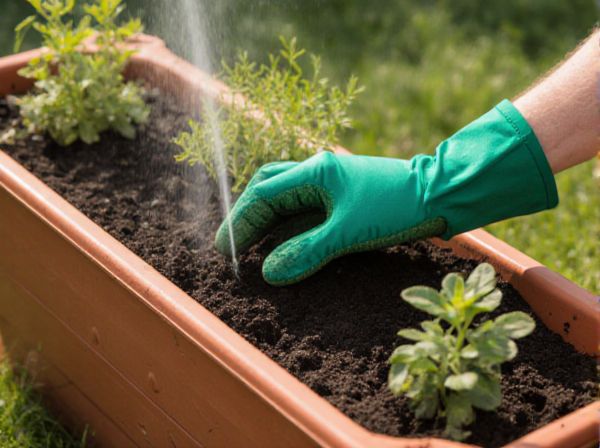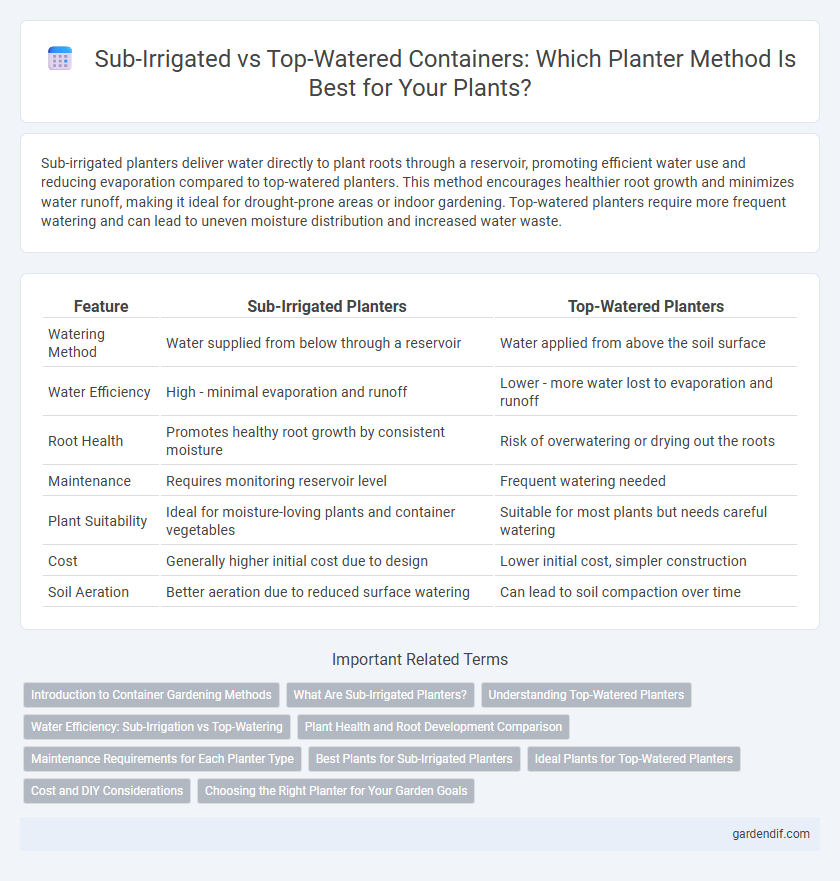
Sub-irrigated planters vs top-watered planters Illustration
Sub-irrigated planters deliver water directly to plant roots through a reservoir, promoting efficient water use and reducing evaporation compared to top-watered planters. This method encourages healthier root growth and minimizes water runoff, making it ideal for drought-prone areas or indoor gardening. Top-watered planters require more frequent watering and can lead to uneven moisture distribution and increased water waste.
Table of Comparison
| Feature | Sub-Irrigated Planters | Top-Watered Planters |
|---|---|---|
| Watering Method | Water supplied from below through a reservoir | Water applied from above the soil surface |
| Water Efficiency | High - minimal evaporation and runoff | Lower - more water lost to evaporation and runoff |
| Root Health | Promotes healthy root growth by consistent moisture | Risk of overwatering or drying out the roots |
| Maintenance | Requires monitoring reservoir level | Frequent watering needed |
| Plant Suitability | Ideal for moisture-loving plants and container vegetables | Suitable for most plants but needs careful watering |
| Cost | Generally higher initial cost due to design | Lower initial cost, simpler construction |
| Soil Aeration | Better aeration due to reduced surface watering | Can lead to soil compaction over time |
Introduction to Container Gardening Methods
Sub-irrigated planters use a reservoir system that delivers water directly to plant roots, enhancing water efficiency and reducing soil surface evaporation. Top-watered planters rely on watering from above, which can lead to uneven moisture distribution and increased water loss through runoff and evaporation. Understanding these container gardening methods helps optimize plant growth, water usage, and maintenance needs in urban and small-space gardening.
What Are Sub-Irrigated Planters?
Sub-irrigated planters (SIPs) use a self-watering system where water is stored in a reservoir below the soil, allowing plants to absorb moisture through capillary action, promoting efficient water use and healthier root systems. This design reduces the frequency of watering and minimizes water runoff and evaporation, making SIPs ideal for container gardening in various environments. By maintaining consistent soil moisture levels, sub-irrigated planters support optimal plant growth and reduce the risk of overwatering or underwatering compared to traditional top-watered planters.
Understanding Top-Watered Planters
Top-watered planters rely on surface watering, where water is applied directly to the soil or plant roots from above, promoting immediate hydration but often leading to uneven moisture distribution. This method can cause soil compaction and runoff, potentially reducing water efficiency and increasing the risk of root diseases due to excess moisture on foliage. Despite these drawbacks, top-watering remains a simple and widely used technique suitable for most container plants lacking specialized irrigation systems.
Water Efficiency: Sub-Irrigation vs Top-Watering
Sub-irrigated planters significantly improve water efficiency by delivering moisture directly to the root zone, reducing evaporation and runoff compared to top-watered planters, which lose more water through surface evaporation. Studies show sub-irrigated systems can reduce water usage by up to 50% while promoting healthier root growth due to consistent moisture availability. This method maximizes water retention and minimizes wastage, making it an ideal choice for sustainable container gardening.
Plant Health and Root Development Comparison
Sub-irrigated planters promote healthier root systems by delivering consistent moisture directly to the root zone, reducing the risk of overwatering and root rot. Top-watered planters often cause uneven soil moisture, leading to surface evaporation and potential stress on roots from fluctuating hydration levels. The consistent water availability in sub-irrigated containers enhances nutrient uptake and encourages deeper, more robust root growth compared to traditional top-watering methods.
Maintenance Requirements for Each Planter Type
Sub-irrigated planters require less frequent watering and reduce the risk of overwatering by providing consistent moisture from the bottom, leading to lower maintenance. Top-watered planters demand regular and careful watering schedules to avoid dry spots or waterlogging, increasing maintenance efforts. Self-watering systems in sub-irrigated containers also minimize nutrient leaching, reducing the need for frequent fertilization compared to top-watered planters.
Best Plants for Sub-Irrigated Planters
Sub-irrigated planters excel with water-loving plants like herbs, lettuce, and spinach due to their consistent moisture delivery system. Plants such as basil, mint, and chard thrive in sub-irrigated environments, benefiting from reduced risk of overwatering and root rot. Ideal for container gardening, these planters optimize growth conditions for moisture-dependent species, enhancing yield and plant health.
Ideal Plants for Top-Watered Planters
Top-watered planters are ideal for plants with shallow root systems, such as herbs like basil and cilantro, leafy greens including lettuce and spinach, and flowering annuals like petunias and marigolds. These planters support plants that require frequent moisture at the soil surface, promoting healthy growth without waterlogging roots. Their design allows quick drainage, preventing root rot in moisture-sensitive species.
Cost and DIY Considerations
Sub-irrigated planters often have higher upfront costs due to specialized reservoirs and wicking systems, but they reduce water usage and maintenance over time, potentially lowering long-term expenses. Top-watered planters are generally more affordable initially and simpler to construct or modify with DIY materials but require more frequent watering and attention to soil moisture levels. When choosing between the two, consider budget constraints, time availability for upkeep, and the intended scale of container gardening projects.
Choosing the Right Planter for Your Garden Goals
Sub-irrigated planters provide consistent moisture directly to plant roots, reducing water waste and promoting healthier growth, ideal for gardeners aiming for efficiency and sustainability. Top-watered planters allow greater control over watering frequency and fertilizer application, making them suitable for plants with varied hydration needs. Selecting the right planter depends on plant species, maintenance preferences, and specific garden objectives such as water conservation or maximizing growth yield.
Sub-irrigated planters vs top-watered planters Infographic

 gardendif.com
gardendif.com